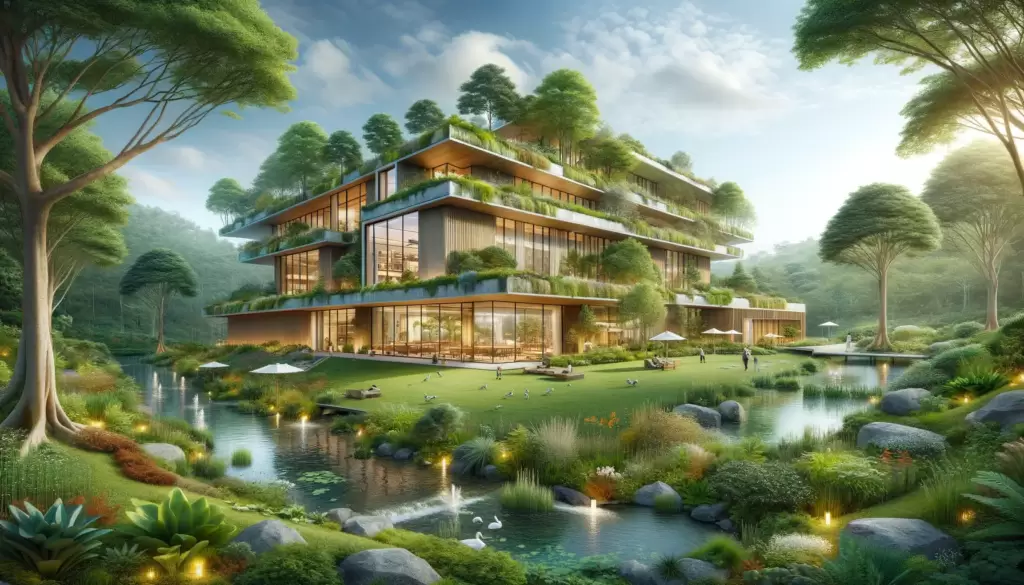
Table of Contents
Defining Architecture and Nature
Architecture and nature have an intimate relationship that goes beyond mere aesthetics. The design of architectural structures is often inspired by the natural world, with architects drawing on the forms, patterns, and materials found in nature to create buildings that harmonize with their surroundings. In essence, architecture serves as a bridge between human-made environments and the natural world, striving to blend functionality with the innate beauty and balance found in nature.
When considering architecture in relation to nature, it’s crucial to acknowledge the sustainable aspect of design. Modern architecture increasingly aims to minimize environmental impact by integrating green spaces, using renewable materials, and incorporating energy-efficient systems. This not only benefits the planet but also enhances our connection with nature within urban landscapes. By embracing natural elements in architectural designs, we can create spaces that foster well-being while preserving the integrity of the environment.
In conclusion, defining architecture in relation to nature involves recognizing its ability to meld human ingenuity with organic principles. Through this fusion emerges a built environment that not only reflects our interaction with nature but also serves as a sustainable testament to our harmonious coexistence with the natural world.
Historical Relationship Between Architecture and Nature
Throughout history, architecture and nature have maintained a complex and dynamic relationship that reflects the cultural, social, and environmental values of different societies. From the ancient pyramids of Egypt to the modern sustainable designs of today, architects have drawn inspiration from nature’s forms, patterns, and materials. The use of natural elements like wood, stone, and water in architectural construction not only reflects a harmonious integration with the environment but also serves as a reminder of humanity’s connection to the natural world.
Furthermore, many historical architectural marvels were designed to coexist with their natural surroundings in a way that honored the landscape rather than imposing on it. For example, Gothic cathedrals were often built using designs that mimicked tree branches or leaf motifs in stained glass windows. This attention to incorporating natural elements into architectural designs was not just an aesthetic choice but also a means to create structures that complemented and respected the environment around them. In this way, architecture has served as a bridge between humanity and nature throughout history, reflecting our understanding of and respect for the world we inhabit.
Modern Approaches to Incorporating Nature in Architecture
In today’s architecture, there is a growing emphasis on incorporating nature into design to create sustainable and harmonious living environments. Modern approaches to this integration go beyond simply adding greenery to buildings; they involve thoughtful consideration of the surrounding ecosystem and natural elements. One innovative approach is biomimicry, where architects draw inspiration from natural forms, processes, and systems to design buildings that mimic the efficiency and resilience of nature. This approach not only leads to visually stunning designs but also fosters a deep connection between occupants and the natural world.
Another modern trend is the use of sustainable materials sourced from nature, such as timber, bamboo, and earth-based materials. By utilizing these renewable resources in construction, architects can minimize their projects’ environmental impact while creating structures that blend seamlessly with their surroundings. Moreover, biophilic design principles play a significant role in modern architecture by prioritizing human-nature connections within built environments. This approach seeks to incorporate elements such as natural light, views of green spaces, and indoor plants to improve inhabitants’ well-being and productivity while reducing energy consumption.
These modern approaches not only elevate architecture aesthetically but also underscore the importance of coexisting with nature in an increasingly urbanized world.
Benefits of Integrating Nature into Architectural Design
Integrating nature into architectural design offers numerous benefits that extend beyond aesthetic appeal. It has been shown to improve occupants’ mental and physical well-being by providing access to natural light, ventilation, and green spaces. By incorporating elements such as living walls, green roofs, and indoor gardens, architects can create a more sustainable built environment that promotes biodiversity and reduces carbon footprint.
Additionally, the integration of nature into architecture can enhance energy efficiency and reduce the reliance on artificial heating and cooling systems. This approach not only contributes to environmental conservation but also yields long-term cost savings for building owners. Furthermore, embracing biophilic design principles in architectural projects can foster a deeper connection between humans and their surroundings, leading to improved productivity, creativity, and overall satisfaction within built environments.
Environmental Sustainability in Architecture
Environmental sustainability in architecture is a critical consideration in today’s design practices. Architects are increasingly recognizing the need to integrate eco-friendly elements into their designs, aiming to reduce the environmental impact of buildings. This entails using renewable materials, optimizing energy efficiency, and incorporating green spaces and natural ventilation systems. By prioritizing sustainability, architects can create buildings that harmonize with their natural surroundings, minimize resource consumption, and contribute to a healthier planet.
Furthermore, the concept of biophilic design has emerged as a key tenet of environmentally sustainable architecture. This approach emphasizes connecting people with nature by integrating natural elements such as plants, natural light, and water features into building environments. Studies have shown that biophilic design not only enhances the aesthetic appeal of architectural spaces but also improves occupant well-being by fostering a deeper connection with nature. In essence, environmental sustainability in architecture goes beyond reducing carbon footprints; it also aims to create symbiotic relationships between built structures and the environment while enhancing human experiences within these spaces.
Examples of Exceptional Architectural Designs with a Strong Connection to Nature
The integration of nature into architectural designs has led to some truly exceptional and awe-inspiring creations. Take, for example, the Fallingwater house designed by Frank Lloyd Wright. This iconic home is built over a waterfall, seamlessly blending with its natural surroundings and creating a strong connection to the elements. Another striking example is the Treehotel in Sweden, which offers unique treehouse accommodations nestled in the forest canopy, allowing guests to immerse themselves in nature while appreciating innovative architectural design.
Additionally, the Salk Institute in California stands out as a prime example of architecture that harmoniously coexists with nature. Designed by Louis Kahn, this research facility overlooks the Pacific Ocean and features open courtyards and sweeping views of the nearby cliffs and ocean, fostering a profound connection with its environment. These extraordinary architectural designs not only showcase human creativity but also demonstrate our ability to honor and embrace the beauty of nature through thoughtful and sustainable construction practices.
Conclusion: Emphasizing the Importance of Harmonious Relationship between Architecture and Nature
In conclusion, the relationship between architecture and nature is an essential aspect of sustainable and harmonious design. By integrating natural elements into architectural designs, such as incorporating green spaces, natural lighting, and sustainable materials, we can create buildings that coexist with the environment rather than imposing upon it. This approach not only benefits the surrounding ecosystem but also enhances the well-being of occupants by fostering a connection to nature within urban environments.
Furthermore, emphasizing the importance of this harmonious relationship between architecture and nature can inspire a shift towards more mindful and environmentally conscious designs. As our society grapples with pressing environmental challenges, architects have a significant role in promoting sustainable practices through their creations. By prioritizing the integration of nature into architectural projects, we can contribute to a more balanced and respectful cohabitation with our natural surroundings while simultaneously creating inspiring and functional spaces for present and future generations.


